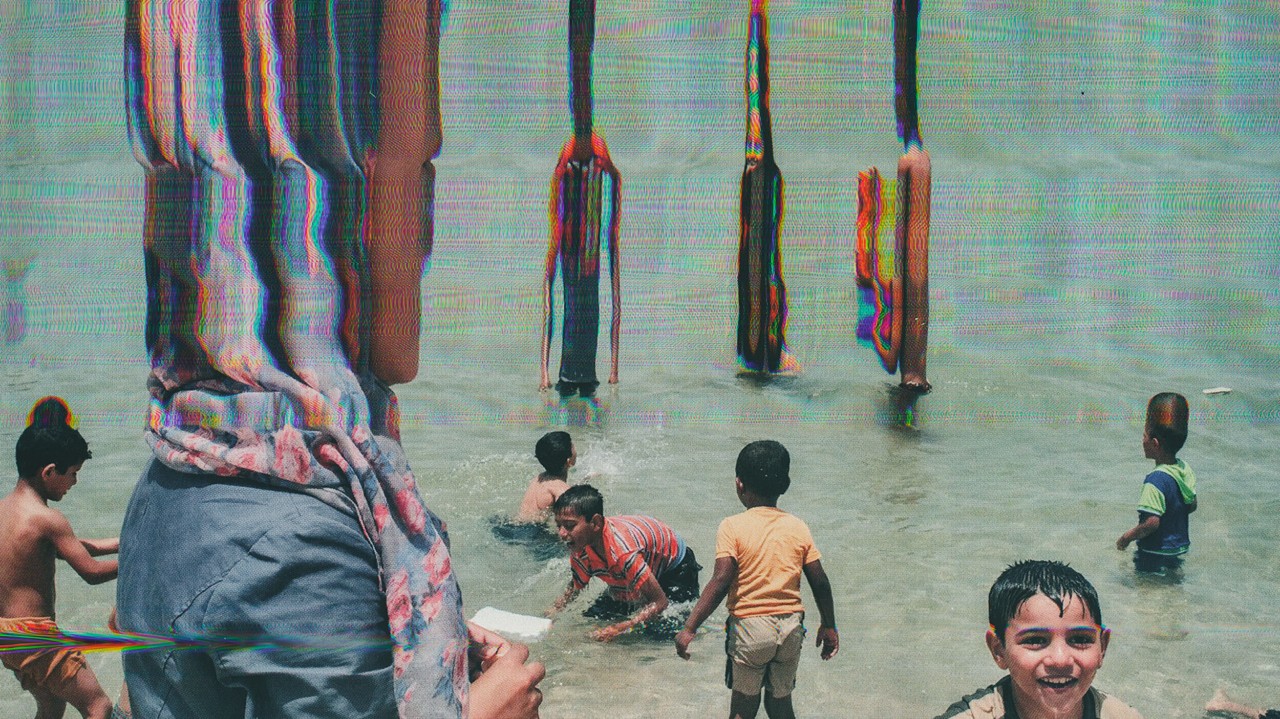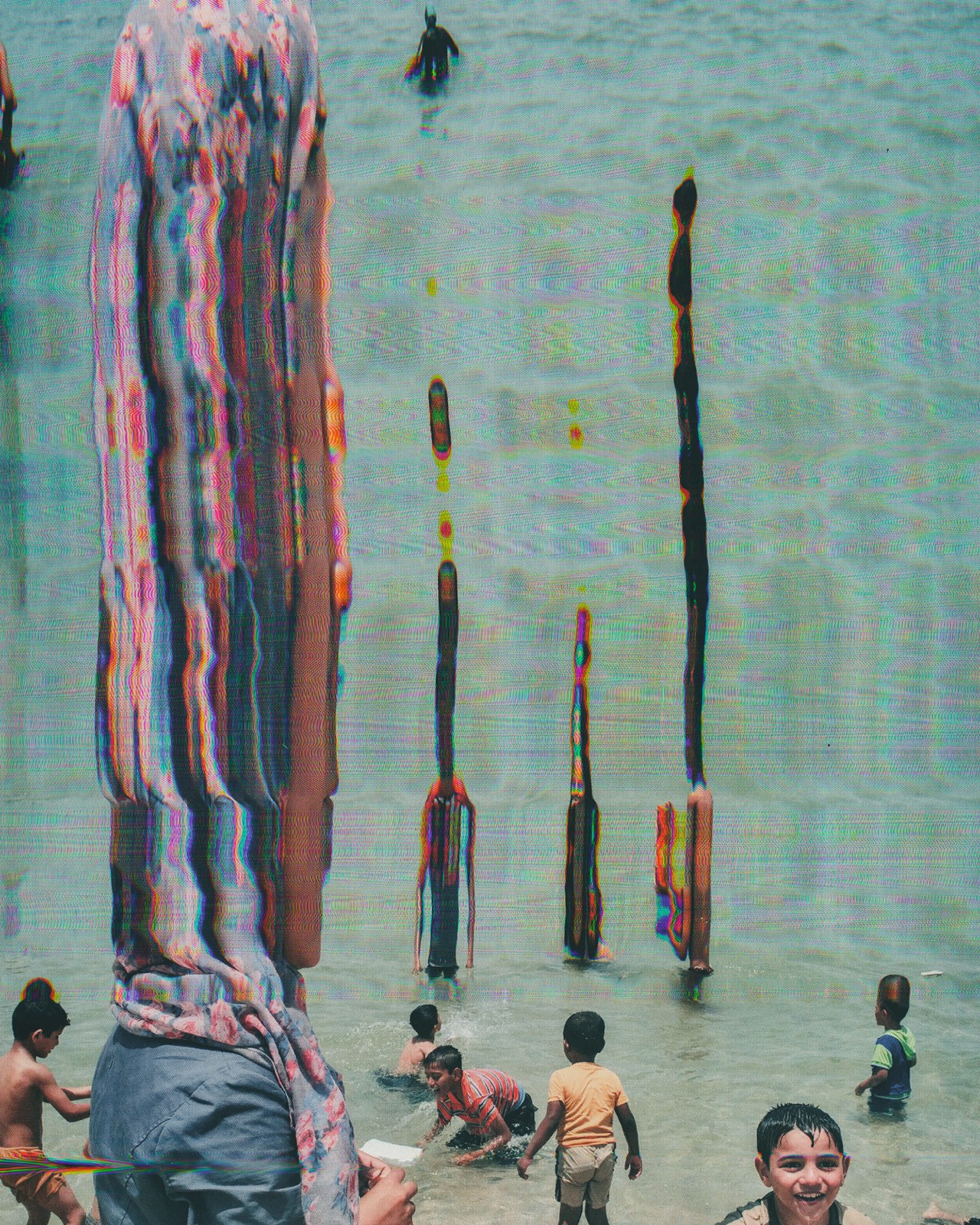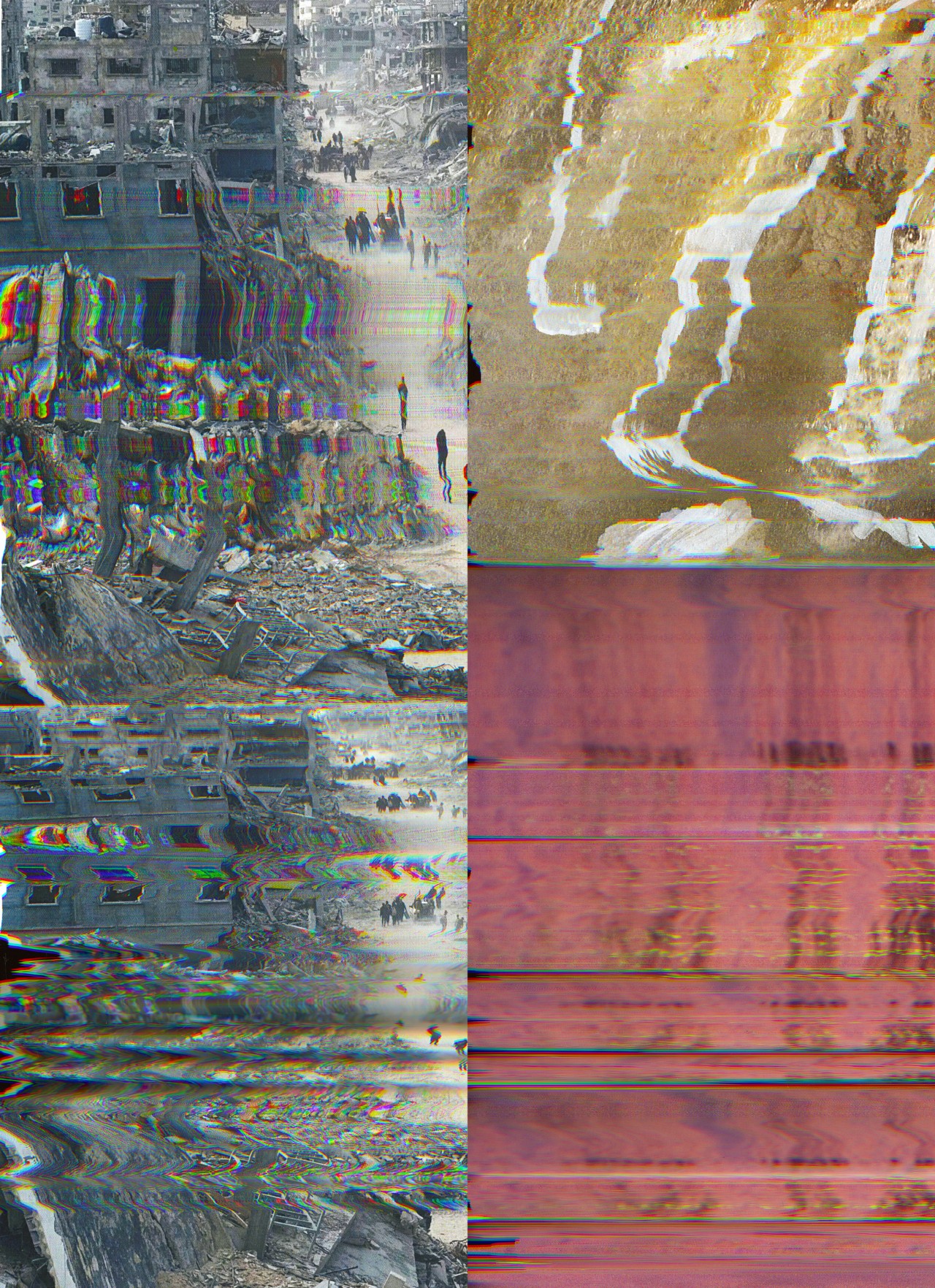

WORDS BY JASON P. DINH
artwork by nico krijno
It was a blustery February day in Cambridge, Massachusetts. Gusts of nearly 50 miles per hour whipped me around the icy sidewalks as I approached the metro station. My destination? The Massachusetts Institute of Technology to see Phoenix of Gaza XR, an art exhibit and research project that allows people to “visit” Gaza—in all its splendor and its strife—through virtual reality.
After a quick visit to the waiting room, where Palestinian liberation songs played through a laptop speaker, I found myself in a small office space sharing a circular table with two other visitors. I strapped on a pair of Meta Quest VR goggles that whisked me 5,500 miles away; before I knew it, Boston’s tempestuous winds were replaced with Gaza’s tranquil skies of days past.
With a few flicks of a joystick, I was sunbathing on Gaza’s beaches, perusing storefronts at a market, and performing on stage at a religious festival. I gazed up at the clouds and down at the children playing in the streets. People chatted over tea in the public square while cars honked at stalled traffic. Everywhere I looked, the city hummed with quotidian life.
“I really felt that, Oh, I just took a walk in Gaza and experienced all these moments, but actually, I’m in Cambridge—and most of these spaces are no longer there, so it’s really sad,” said Ezrena Marwan, who visited the exhibit at the same time as me. Marwan works for a global campaign called Whose Knowledge? that aims to center the knowledge of marginalized communities on the internet. “It humanized the space for me because I’ve never been to Gaza,” she said. “I’ve never been to Palestine. It’s always just either images or movies, but not something that is very, very real.”
These joyful, resilient, and mundane stories are at the heart of the exhibit, said Phoenix of Gaza XR cofounder Naim Aburaddi. Born and raised in Gaza—and now pursuing a Ph.D. in media studies at the University of Colorado Boulder—Aburaddi knows that his people are more than victims of war. His team began capturing 360-degree photos and videos from Gaza in 2022 to portray the city holistically through virtual reality; they’ve continued since the genocide began in October 2023. As more than 60,000 Palestinian people have been killed, 90% of Gaza’s population displaced, and nearly 70% of its buildings destroyed, the project has taken on a second role: an archive of cultural memory.
“We didn’t intend this, but obviously we kept a treasure for them, a trove of memories that were violently destroyed,” said project cofounder Dr. Ahlam Muhtaseb, a media studies professor at California State University, San Bernardino who is originally from al-Khalil (Hebron) in the West Bank. “One day, we will take it to Gaza and have people relive those memories.”
View this post on Instagram
Growing up in Gaza, Aburaddi lived through multiple wars and the Israeli blockade. His turbulent childhood inspired the name, Phoenix of Gaza.
“Every time the war ended, the first thing that we [did was] rebuild our house,” Aburaddi said. After Israel blocked the import of building materials starting in 2007, people began recycling rubble to reconstruct their homes.
“That’s the people of Gaza,” Aburaddi said. “They will find a way to make life out of nothing. To rebuild and to come again out of the ashes, out from the rubble—that’s the Phoenix.”
Aburaddi’s love for country shines through when he speaks, but he hadn’t returned for six years when the project first started. “I was never allowed to go back to Gaza because of the Israeli blockade and the Egyptian restrictions,” he said. Yearning for his hometown, he got the idea of using VR as a decolonial tool to take him back.
Working with Muhtaseb and others, Aburaddi, then a master’s student at Cal State San Bernadino, hired a war photographer in Gaza named Ahmad Hasaballah to walk around public spaces with a 360-degree camera. Aburaddi was stunned by the first footage Hasaballah sent them—of Hamam al-Sammara, a 1,000-year-old, Ottoman-era public bathhouse.
“It’s not like any other technology,” Aburaddi said. “You feel like you are immersed there… You feel like you are there and people are talking to you, walking by you. I really started crying because of the happiness.”
The team quickly expanded to document other places: landmarks like Shuja’iyya market and the downtown hub of Rimal, but also everyday activities like parties, weddings, poetry readings, and dance performances. While Hasaballah filmed, the team stateside developed a virtual reality environment to showcase their recordings. Then, as they prepared to debut the show a year later, October 7, 2023 came.
Many of the buildings they filmed were swiftly leveled. By December, Hamam al-Sammara was bombed and destroyed. Other institutions they filmed met the same fate: the Great Omari Mosque, Palestine’s oldest mosque; Al-Shifa Hospital, the largest medical complex in Gaza; and Abu Zahir Pastries, an ordinary neighborhood bakeshop, just to name a few. Still, the team kept recording through it all. They captured photos and videos of places they cataloged earlier but are now nothing but debris, immersing exhibit visitors in stunning before-and-after footage.
The work has happened alongside great personal loss and sacrifice. Photographer Hasaballah lost his father, his house was destroyed twice, and he was evacuated to Egypt.
“That’s the people of Gaza. They will find a way to make life out of nothing. To rebuild and to come again out of the ashes, out from the rubble—that’s the Phoenix.”
Their new photographer, Yahya Sobeih, has continued the work, but he lost his uncle, cousin, sister, and his sister’s only child, who took seven years to conceive due to fertility issues.
For Sobeih, documenting the vicious and indiscriminate razing of his hometown has been devastating. “Everywhere you go, there’s destruction,” he told me from Gaza in Arabic through a translator. “Naturally, we feel sadness; we feel pain. We recall the memories we once had in these places, how they used to be, and what they’ve turned into now.”
Nonetheless, Sobeih sees life glowing in the embers. We spoke on Monday during Ramadan, shortly after he recorded a small gathering for iftar in Tel al-Hawa—a neighborhood that was occupied by Israeli forces for over a year. He recalled his favorite videos of children laughing and playing; one memorable shot shows a group of young boys driving bumper cars, jostling over the camera.
“Despite everything we’ve been through, despite the destruction and all the hardship we’ve endured, you still find glimpses of life emerging,” Sobeih said. “In Gaza, people love hope, they love life, they don’t love wars. But wars are something they’ve been forced into.”
Mere hours after Sobeih and I spoke, Gaza was forced into war once again. Later that evening, the short-lived and half-abided ceasefire deal shattered; Israel bombed the Gaza Strip and killed more than 400 people.
Phoenix of Gaza is a first-of-its-kind project. Nowhere else are immersive technologies being used to capture historical records as they are being destroyed, said Dr. Jonathan Wyrtzen, a sociologist and historian at Yale University.
“You’ve created the only extant record and archive of a lot of things,” Wyrtzen said. “There’s nothing like this.”
Wyrtzen isn’t involved with the exhibit, but he helped bring Phoenix of Gaza to Yale last December. He recalled how many of the exhibit’s visitors wept after seeing the footage. Some from Gaza reminisced on places they once knew; others who had little attachment to the region were quickly awakened to the urgency of the crisis.
“They got drawn into it and were affected by it,” Wyrtzen said. “I think the world—it opened up for them through putting on a 3D set and being able to be transported like that.”
Wyrtzen had never used VR before and was skeptical at first. But seeing the exhibit changed his mind. He said the technology could be “transformative” as a historical medium. He recalled a video where children at a party ran past shouting their names at the camera—and at you, the exhibit visitor. Never has history been so immersive.
“It’s a new and unique way to interact with the past,” Wyrtzen said, lamenting the loss of so many people featured in the project. “You just don’t know who’s alive and who’s not with us.”
But, as the cliché goes, history doesn’t just idly catalog the past; it informs the future—and that’s the next phase for the Phoenix of Gaza XR.

The team’s forward-looking vision was evident during my visit to the exhibit, which was part of a symposium at MIT about how urban planning and design can address violent settler colonialism in Palestine. “Urban design is a political field and a political force, and you can’t ignore that within your work,” said a symposium organizer and master’s student in city planning at MIT who was granted anonymity for fear of reprisal.
The symposium probed how architecture “has actually been a violent act of genocide,” said another symposium organizer who was granted anonymity. Speakers and attendees, including Aburaddi and Muhtaseb, ideated another way forward—one that prioritizes the liberation and agency of Palestinians.
Indeed, Aburaddi and Muhtaseb have already brainstormed how their project can inform the Gaza of the future. They’re working with architects, urban planners, and experts in virtual reconstruction “to try to imagine different avenues for the project in helping people on the ground,” Muhtaseb said. Most buildings have been damaged or destroyed, but their team is dreaming up ways to build each one back better.
“The silver lining in all of this [is] an opportunity to actually improve their life conditions by rebuilding Gaza the way Palestinians see it and want it—to make it a haven for Palestinians,” Muhtaseb said.
The team also wants to help Palestinians now. For example, they’ve been working with a group of therapists to use their footage to help Gaza’s children relive happy memories. They hope that can help Gazans heal from the trauma of genocide.
At the end of the day, this initiative is about providing agency to the Palestinian people. That was the group’s guiding light before October 7, and it remains so today.
“We started this project trying to defy the colonial impositions on us,” Muhtaseb said. “And by that I mean the constant siege and blockade of Gaza, and the death and destruction, and the different words that force people to keep on talking about Gaza as a victim. We wanted to give the people of Gaza the agency they deserve for resistance and resilience.”
Aburaddi echoed that resolve. No matter how many munitions Israel fires, he said he knows Gaza will survive in its people and their memory.
“They were able to destroy the locations, to kill people, and to destroy the whole city of Gaza, but they will never attack our memory. That’s what we have now in this project,” Aburaddi said. “It’s going to be a beautiful city again; we will rebuild it. And again, the Phoenix of Gaza—the name itself—it says it all.”
Translation by Dina Bahhour
Pioneering Virtual Reality Exhibit Immerses Users in a Liberated Gaza
